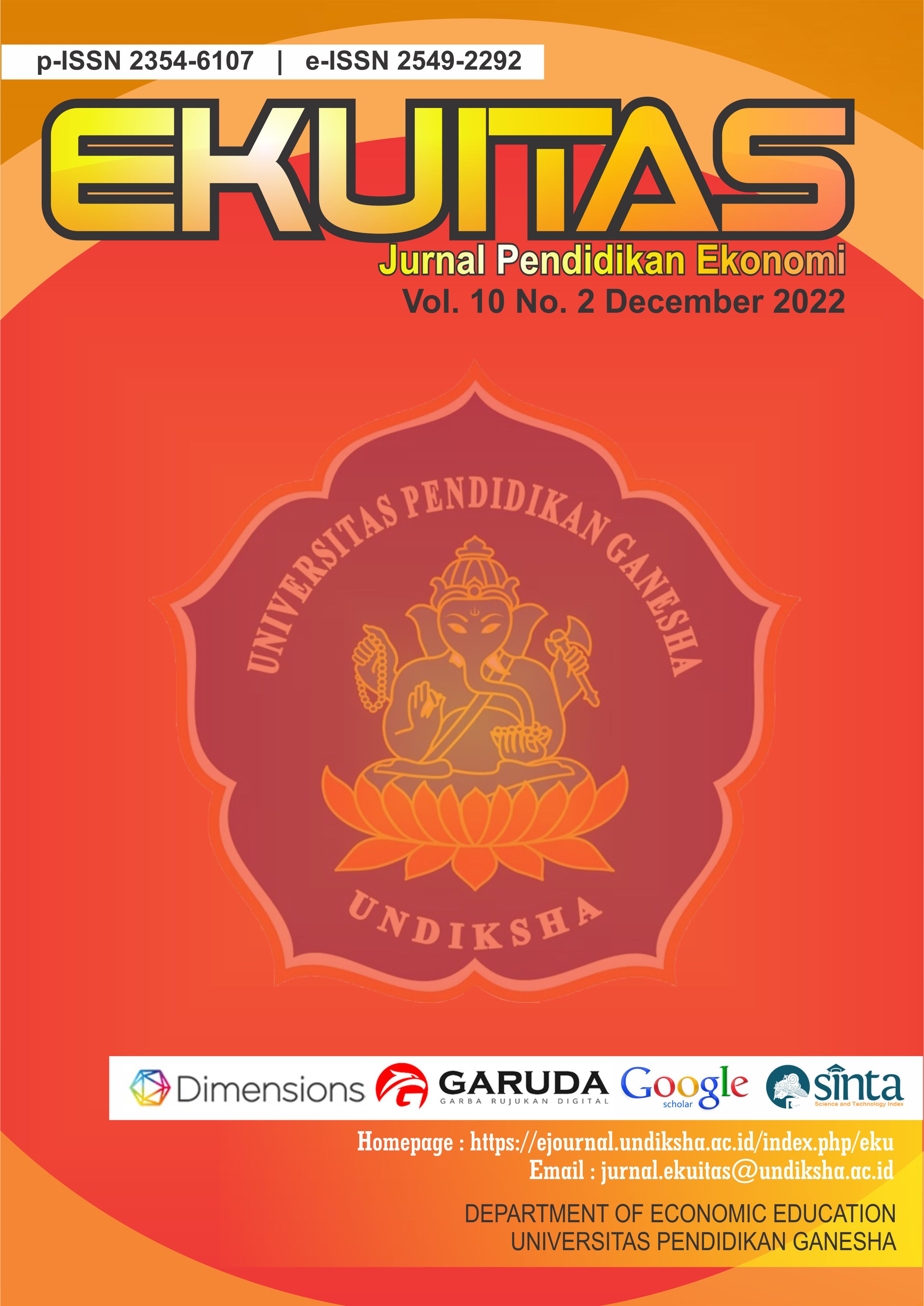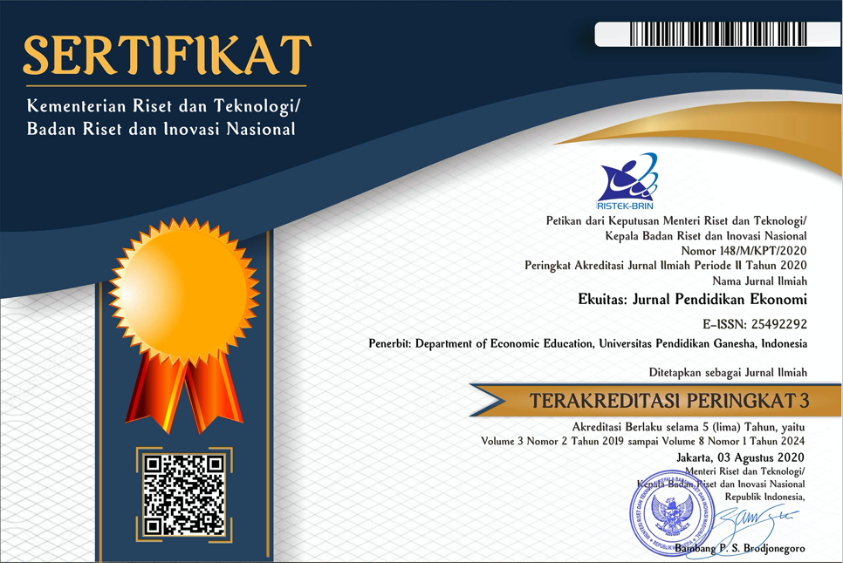Pengaruh Persepsi Kebermanfaatan dan Kemudahan Terhadap Kecemasan Berkomputer Guru SMK Jurusan Akuntansi dalam Mengajar Praktikum Akuntansi Pemerintah
DOI:
https://doi.org/10.23887/ekuitas.v10i2.54287Keywords:
Computer anxiety, perceived ease of use, perceived usefullness, siskeudes v.2, vocatinal high school teachersAbstract
This research is important because the acceptance of the Siskeudes V.2 application by teachers will determine the success of teachers in teaching. The purpose of this study was to determine the effect of perceived of ease and perceived usefulness of the village financial system software (Siskeudes V.2) on computer self-efficacy of vocational high school teachers. This research was a quantitative research, data was obtained through questionnaires from vocational high school teachers who taking the course of Siskeudes V.2. Data were analyzed by Partial Least Square (PLS) using Smart PLS 3.0. Results of this study are perceived ease of use and perceived usefulnes affects computer anxiety vocational high school teachers. Most of the 29 respondents stated that the benefits of training using the software needed for training according to the needs and perceptions of usefulness required. The results showed that the value of R2 = 39%, meaning that 39% of the variance of computerized vocational school teachers' computerized anxiety regarding the Siskeudes V.2 application was influenced by the variables perceived usefulness and perceived convenience. The results of testing the hypothesis are supported at alpha 5% with T Statistics values H1=2,1519 and H2=1,7398 which values are already above 1,64 for the one-tailed hypothesis.This research makes a practical contribution to the implementation of training in the use of software applications that the training should aim to create perceptions of ease and perceived usefulness so that it is expected to produce a low impact of computer anxiety.
References
Ali, S., & Fadila. (2008). Kecemasan Berkomputer ( Computer Anxiety ) Dan Karakteristik Tipe Kepribadian Pada Mahasiswa Akuntansi. Simposium Nasional Akuntansi Ke‐11, Pontianak., 1–35.
Budiman, F., & Arza, F. I. (2013). Pendekatan Technology Acceptance Model Dalam Kesuksesan Implementasi Sistem Informasi Manajamen Daerah. Wahana Riset Akuntansi, 1(1), 87–110. http://ejournal.fip.unp.ac.id/index.php/wra/article/view/2315
Compeau, D. R., & Higgins, C. A. (1995). Computer Self-Efficacy: Development of a Measure and Initial Test. MIS Quarterly: Management Information Systems, 19(2), 189–211.
Davis, F. D. (1989). Perceived usefulness, perceived ease of use, and user acceptance of information technology. MIS Quarterly: Management Information Systems, 13(3), 319–339. https://doi.org/10.2307/249008
Effiyanti, T., Stats, S., & Sawiji, H. (2014). Pengaruh Computer Anxiety Dan Technology Acceptance Model (Tam) Terhadap Technostress Pada Guru Smk Di Kabupaten Karanganyar. Jurnal Pendidikan Insan Mandiri, 1(1), 13863.
Febriyani, K., & Suprajitno, D. (2020). Analisis Pengaruh Technology Acceptance Model (TAM) Pada Penggunaan Sistem Keuangan Desa. Jurnal Ilmiah Mahasiswa Manajemen, Bisnis Dan Akuntansi (JIMMBA), 2(4), 515–528. https://doi.org/10.32639/jimmba.v2i4.625
Handayani, S., & Kawedar, W. (2004). Pengaruh Komputer Mikro Terhadap Kinerja Dan Kepuasan Kerja Auditor. Jurnal Akuntansi & Auditing, 01(01), 50–65.
Harrison, A. W., & Rainer Jr, R. K. (1992). The influence of individual differences on skill in end-user computing. Journal of Management Information Systems, 9((1)), 93–111.
Haswindy, S. (2019). SISKEUDES DI PROVINSI JAMBI Testing the Acceptance of Technological Aplication of Siskeudes in Jambi Province E-gov dalam wilayah perkotaan dan perdesaan adalah komunitas informasi dan faktor-faktor. 3(12), 591–609.
Hatta, M., & Marietza, F. (2013). Kecemasan dalam Penggunaan Software Akuntansi dari Perspektif Gender dan Pengaruhnya terhadap Keahlian Pemakai dengan Locus Of Control sebagai Variabel Moderasi. Simposium Nasional Akuntansi Xvi, September 2013, 4067–4565. http://repository.unib.ac.id/id/eprint/6414
Igbaria, M., & Parasuraman, S. (1989). Influence of Demographic Factor and Personality to End User Computing In Microcompute. Journal of Accounting Research, 15(3), 373–388.
Jogiyanto, H. M., & Abdillah, W. (2009). Konsep dan aplikasi PLS (Partial Least Square) untuk penelitian empiris. BPFE Fakultas Ekonomika dan Bisnis UGM.
Kemendikbud. (2018). Direktorat Jenderal Pendidikan Dasar dan Menengah Kementerian Pendidikan dan Kebudayaan. July, 1–23.
Kesumman, P. M., & Suardikha, I. M. S. (2016). Penggunaan Sistem Informasi Pengelolaan Keuangan Daerah Terhadap Kinerja Pegawai Pada Satuan Kerja Perangkat Daerah. E-Jurnal Akuntansi Universitas Udayana, 15(2), 1115–1144.
Lusiono, E. F., & Suharman. (2017). Lingkungan Pemerintah Daerah. Jurnal Akuntansi, Ekonomi Dan Manajemen Bisnis, 5(2), 163–172.
Pratiwi, D. N., & Pravasanti, Y. A. (2020). Analisis Penggunaan Siskeudes dalam Pengelolaan Dana Desa. Jurnal Akuntansi Dan Pajak, 20(2), 217–223.
Rifa, D., & Gudono, G. (1999). Pengaruh Faktor Demografi dan Personality terhadap Keahlian dalam End-User Computing. Jurnal Riset Akuntansi Indonesia, 2(1).
Sayekti, F., & Putarta, P. (2016). Penerapan Technology Acceptance Model (TAM) Dalam Pengujian Model Penerimaan Sistem Informasi Keuangan Daerah. Jurnal Manajemen Teori Dan Terapan| Journal of Theory
and Applied Management, 9(3), 196–209. https://doi.org/10.20473/jmtt.v9i3.3075
Syarwani, A., & Ermansyah, E. (2020). Analisis Penerimaan Teknologi Sistem Keuangan. Program Studi Teknologi Pendidikan, 4, 1–13.
Triana P.W., K. S., Kurniawan, P. S., & Dewi, P. E. D. M. (2018). Pengaruh Persepsi Kemudahan, Persepsi Kebermanfaatan, Computer Self Efficacy, dan Kesesuaian Tugas Terhadap Penggunaan Sistem Keuangan Desa (Studi Kasus Pada Desa-desa Penerima Dana Desa Se-Kabupaten Buleleng). JIMAT ( Jurnal Ilmiah
Mahasiswa AKuntansi), 9(3), 63–72.
Widagdo, A. K., Ika, S. R., & Satria, S. (2020). Jurnal Akuntansi dan Bisnis. Jurnal Akuntansi Dan Bisnis, 20(1), 32–44. https://doi.org/https://doi.org/10.20961/jab.v20i1.507
Downloads
Published
How to Cite
Issue
Section
License

This work is licensed under a Creative Commons Attribution-ShareAlike 4.0 International License.








